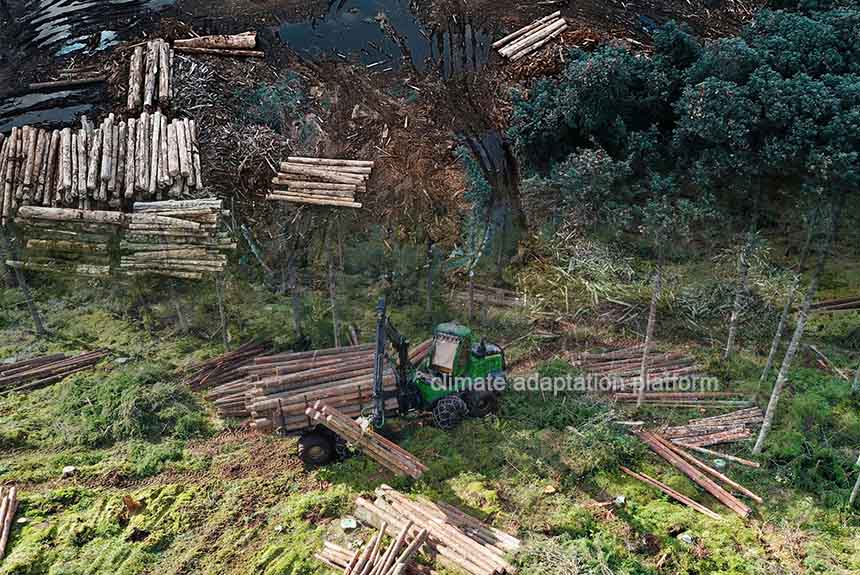A year ago, between February 12 and 16, Cyclone Gabrielle devastated parts of the North Island of New Zealand.
The cyclone also highlights a problem in the forestry sector: slash. Branches and debris called “slash” are the litter foresters leave behind in the hillside to rot after they harvest the precious timber.
NZ Herald reports that heavy rains from Cyclone Garbriel caused an avalanche of logs and branches to flow downhills, causing mayhem. The slash knocked out bridges, roads, and private property, smashing farmlands and riverbeds and endangering lives. It also scourged land and riverbeds, cutting off communities and wrecking infrastructure.
The devastation caused by the slash will no doubt remain long in the memories of these communities as they look for solutions to ensure that this does not happen again. Ross Waugh’s Climate Adaptation Infrastructure Management Series provides further information.
Slash, a forestry waste, is an example of biomass that can help countries meet their decarbonisation targets. Biomass is any material from living things, including wood, bark, leaves, stems for plants and even animal manure.
Biomass carbon removal potential comes from its capacity to absorb CO2 from the atmosphere and store it within its structure. This carbon removal potential can be explored more when biomass is converted into products such as hydrogen or fuels.
Bioenergy with carbon capture and storage (BECCS) is one solution to slash emissions and meet the Paris Agreement goal of limiting warming to 1.5 °C or below 2°C. BECCS involves using biomass to convert it into fuels or directly burn it to produce energy.
WRI article shows that the most sustainable way of using biomass to fight climate change is using residues from agriculture or forestry activity while prioritising land use for food production. Growing plants or vegetation solely for biofuel can have adverse impacts.
A study published in Nature shows land use change in the US can hurt the global capacity to store carbon and reduce GHG emissions. Biomass and biofuel crops are land-intensive and could displace food production.
Other adverse effects of biofuel production include increased GHG emissions from fertiliser and harvest equipment use, land degradation from soil erosion, and decreasing soil capacity to sequester carbon.
The study concludes that any decisions to change land use should consider their implications for GHG emissions and their impact on land capacity to store carbon.
Studies show that biomass from agricultural waste and residues provides a more sustainable way of producing bioenergy.
In New Zealand, 1News reports that researchers at the University of Canterbury are working on a method to turn forestry slash into green energy.
University of Canterbury professor Shusheng Pang says his research aims to convert woody biomass, including low-grade logs and slash, into green hydrogen and CO2. The process involves drying the slash, turning it into chips, and converting them into pure hydrogen and pure CO2 (Researchers Working, 2023).
Another New Zealand-based company, OneFortyOne, plans to turn this unwanted forestry waste into biofuel. According to the business, slash can be used as biofuel when salvaged, recycled, and repurposed. Adding that biofuel made from slash can also help organisations move away from coal and fossil fuels to cleaner energy sources.
Both NZ companies see huge potential in turning slash, a forestry waste viewed as a problem, into a climate solution—helping the country meet its decarbonisation goals while creating a sustainable and unlimited source of renewable bioenergy.
Source:
Edwards, B. (2023 February 27). Political Roundup: The horrific damage caused by forestry slash and vested interests. NZ Herald. Retrieved from https://www.nzherald.co.nz/nz/political-roundup-the-horrific-damage-caused-by-forestry-slash-and-vested-interests/
Searchinger, T.D., Wirsenius, S., Beringer, T. et al. Assessing the efficiency of changes in land use for mitigating climate change. Nature 564, 249–253 (2018). https://doi.org/10.1038/s41586-018-0757-z
Denvir, A. & Leslie-Bole, H. (2024, January 16), Biomass Can Fight Climate Change, but Only if You Do it Right. World Resource Institute. Retrieved from https://www.wri.org/insights/sustainable-biomass-carbon-removal?
Saravanan, A., Deivayanai, V. C., Anish, M., Jayaprabakar, J., Baigenzhenov, O., & Hosseini-Bandegharaei, A. (2023). Agricultural waste biomass for sustainable bioenergy production: Feedstock, characterisation and pre-treatment methodologies. Chemosphere, 331, 138680. https://doi.org/10.1016/j.chemosphere.2023.138680
Researchers working to turn forestry slash into green energy. (2023, March 17). 1 News. Retrieved from https://www.1news.co.nz/2023/03/17/researchers-working-to-turn-forestry-slash-into-green-energy/
How Forestry Slash Can Become A Positive Resource. (2023, March 31). One Forty One. Retrieved from https://onefortyone.com/news/how-forestry-slash-can-become-a-positive-resource



Leave a Reply